How Marlee Matlin and Troy Kotsur Helped the 2023 Media Access Awards Make History
- Oops!Something went wrong.Please try again later.
- Oops!Something went wrong.Please try again later.

When Marlee Matlin began her career 35 years ago, she says there was “nothing” in terms of accessibility in the awards industry space. But that’s begun to change, especially following her film CODA’s best picture win in 2022, including at the 2023 Oscars, where she saw a “significant improvement.”
“I’ve seen changes in award shows and how they are perceived by people who attend them, by producers, by the people who make the decisions as to what to present on the air — all the little things,” she tells The Hollywood Reporter. “CODA really was a game changer and made a huge impact in terms of equity, accessibility, and just how people are perceived in general.”
More from The Hollywood Reporter
The Oscars, for which Matlin serves on the Academy of Motion Picture Arts and Sciences’ Board of Governors, has in the last several years taken the lead among the major Hollywood award shows in its efforts to make a more accessible in-person ceremony and telecast. But according to the actress, much of the space is still operating at a deficit, especially in her experience as it relates to deaf talent.
“From what I’ve seen, we still, unfortunately, have to remind people that there will be deaf people who will be attending. We have to remind them that if there are, there need to be interpreters there to facilitate, to understand what’s going on. We have to remind them that the show needs to be captioned. We have to make sure that the interpreters are properly lit for deaf people and where they sit, so they can see the show and see the interpreter at the same time,” she explains.
Matlin says there have been many times where her equitable “access was not there 100 percent.” In these cases she politely but firmly speaks up, pulling double duty as attendee and accessibility advisor in the down to the wire moments. In the case of one rehearsal walkthrough, it resulted in an unexpected hour-long delay.
“I don’t want to call it worrying, but I’m still attending with something in the back of my mind saying, ‘How is it going to look? Who are the interpreters? Where are they going to place it? Where are we going to sit?'” she says. “More and more, they’re all talking about DEI — everybody in Hollywood. But they forget about access and accessibility. They forget that there is a group of us that needs access to be part of the whole picture.”
Sometimes issues around access aren’t even sparked by the event’s planning organization. The Oscar winner and her long-time interpreter Jack Jason recalled to THR how at one ceremony, a notable filmmaker and his guests openly questioned why Matlin was at the table closest to the stage and they weren’t. The duo acknowledges it’s a spot typically reserved for the evening’s biggest names, but they say Matlin had been placed there to support her access to the show and visibility of the ASL interpreter.
“You have to educate these award shows regarding where Deaf folks should sit, the lighting, and where the interpreter should be,” Matlin’s CODA co-star and fellow Oscar winner Troy Kotsur tells THR. “Sometimes they’ll try and mic me rather than my sign language interpreter, and I’ll say, ‘Hey, it’s my interpreter who needs the mic. Not me.'”
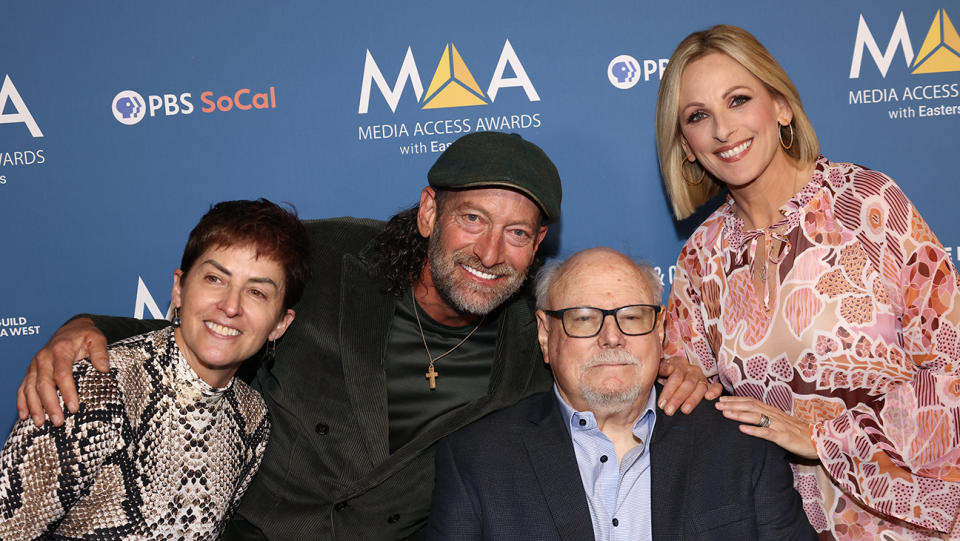
***
The awards circuit has historically been a challenge to navigate for artists with disabilities, but there’s at least one ceremony that Kotsur and Matlin say has been a constant ally and support: the Media Access Awards.
Founded by Norman Lear in 1973, the annual event began as a breakfast but was revamped following Deborah Calla and Allen Rucker’s takeover in 2010. Now presented by Easterseals Disability Services, the MMAs have evolved into one of the biggest and exclusive industry celebrations of actors, film, and TV projects inclusive of disabled characters and performers, helping advance the portrayal and employment of people with disabilities in Hollywood.
As part of its 2023 ceremony, the awards — held a little over a month ahead of the start of the major awards season — were hosted by Kotsur and Matlin at an in-person event honoring disabled industry members and non-disabled allies. That includes Simon Cowell; New Amsterdam executive producers Peter Horton and David Shulner; Still: A Michael J. Fox Movie director Davis Guggenheim; Dahmer director Paris Barclay; The Sex Lives of College Girls actor Lauren “Lolo” Spencer; casting agents Danielle Aufiero and Amber Horn; and Daruma actor Tobias Forrest.
While the MMAs has a history of featuring hosts from the Deaf community along with those from the wider disability community, the 2023 ceremony marks the first time two performers who are deaf have done so.
“Historically, all these doors have been closed in the past, so it’s nice to see them begin to open,” Kotsur tells THR ahead of the show. “It’s a great way to increase awareness of sign language and expose the public to how we can work as a team and how we can seamlessly work together with interpreters voicing for us. I think that will help Hollywood think outside the box at these award shows and various studios.”
“Marlee and I both happen to be Oscar award-winning Deaf actors,” Kotsur added. “So it was really great to share that and celebrate that with each other and with the audience.”
This year’s show is also set to achieve another first in MMAs history: The recorded Nov. 7 ceremony will air on Sunday, Dec. 3 on KCET and then again on PBS SoCal on Dec. 15, with the entire show also available to be streamed on each broadcaster’s respective websites and the free PBS app nationwide. “We feel so blessed to be in partnership with PBS SoCal/KCET and streaming services,” says executive producer Deborah Calla. “They were a fan of the show and our mission and welcomed us into their family with open arms.”
These are big steps for a show that can offer a blueprint for the wider awards community still facing accessibility-related challenges — like proper captioning during a telecast and a means for disabled presenters to have equal access to the stage.
“The Media Access Awards knew what they were doing. It was much smoother and it was a big difference,” Kotsur said of his time hosting the 2023 show. “I think it’s really important for them to set an example for the rest of the industry and the rest of award shows that people with disabilities are diverse. We’re not a monolith, and it’s not a one-size-fits-all [approach] for every award show.”
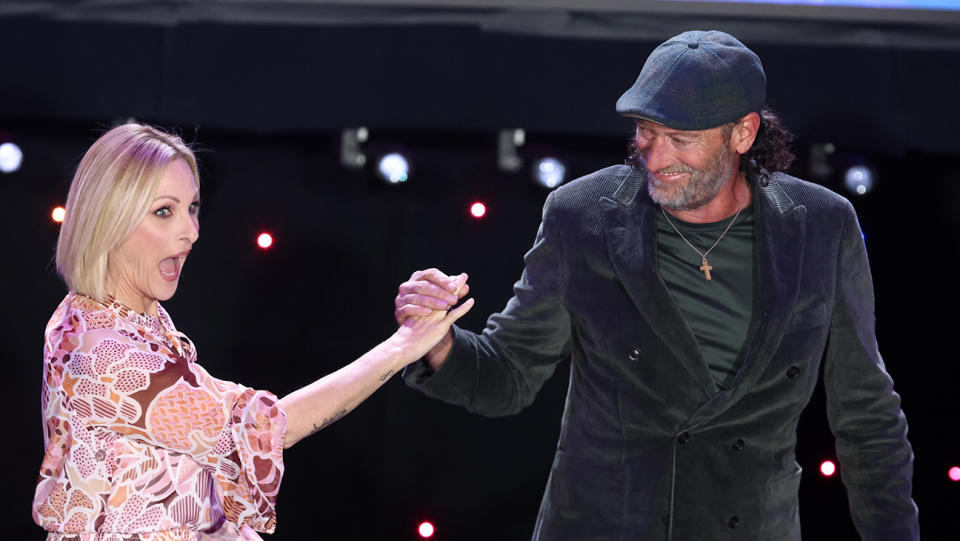
***
Each year, that approach begins to take shape in June, which is when Calla — a former chair of the Producers Guild of America’s diversity committee — and her team hash out details like the honorees, presenters and location. This year’s event landed at the Avalon near Hollywood and Vine, with Calla and her team working through September on how to make the physical experience accessible for a broad range of people, inside and outside of the venue.
Calla’s longstanding relationships with those in Hollywood’s disability community — including show writer Rucker, who uses a wheelchair — provide her with behind-the-scenes consultation throughout that process, helping the show anticipate what considerations should be made before attendees even arrive.
And even then, the show is still sure to engage attendees as “we don’t fully know the needs of guests,” she says. That means an ask on the invitations for specific requests one might have or offering support through rehearsal walkthrough opportunities. “From the get-go, we are letting our guests know we want to be as accessible as possible and giving them the opportunity to let us know how best to accomplish that,” Calla says.
Outside, in line with the same measures they’ve taken since 2011, the MMAs red carpet is designed wide enough to be accessible to wheelchairs, shorter to avoid attendees traveling a longer distance, and made of a material that isn’t so thick it would impede one’s ability to walk independently or with an aid. Additionally, two to three interpreters are present on the carpet, along with an MMA ambassador who serves as a correspondent.
For 2023 that was Molly Burke, a beauty vlogger and social media influencer who is blind. In one of the night’s typically most crowded locations, she was given enough space for both her and her guide dog, as she worked alongside a cameraman interviewing talent for the award’s social channels.
Honorees, presenters and guests then make their way into the venue, where an additional interpreter is available to assist hard-of-hearing or deaf attendees to their seats following a stop at the check-in table. There, signs — including a version in braille for low vision or blind guests — ask like the invitations for guests’ specific requests or needs.
***
Inside the venue, room and stage modifications helped make the experience more seamless to ensure “people are going to move about this physical environment like anybody else,” Calla says. Beyond basic assurances like accessible bathrooms, the event was limited to 130 guests, a careful calculation that allowed for “enough space between the tables that anyone could get around from the first row to the last.”
This year’s tables also featured shorter flower arrangements, a decision that was made after Matlin flagged an issue during rehearsal. “We had the set designer come in and she had two-to-three-feet-high flowers on each table, which would impede the view to the interpreter,” Calla explains. “So they became tiny flowers on the tables.”
“They cut [the flowers] off, immediately,” Matlin notes. “That’s accessibility.”
The stage itself had a ramp constructed for the backstage, alongside a 32-foot front of stage ramp and an additional lift “to get our presenters and recipients to the stage,” the MMAs producer notes. That decision followed a design process with vendors that at one point proposed lowering the theater’s four-foot stage by two feet to support people with dwarfism, those who use mobility aids, and others. They ultimately stuck with the original height specifications to support “people that are harder of hearing, where height is also important” to their active participation, the producer explains.
“We ended up at the Avalon which is the historic theater, so you know accessibility was in no one’s mind at the time it was being built. But I love the space and I thought, because we are a lower budget production, I also look for something that has that spark that I can add to instead of building it from the start,” Calla says. “It’s all about check marks on everything: creating a show that looks good, that is fun, and that is really accessible. None of that should be sacrificed and there is a way of doing it.”
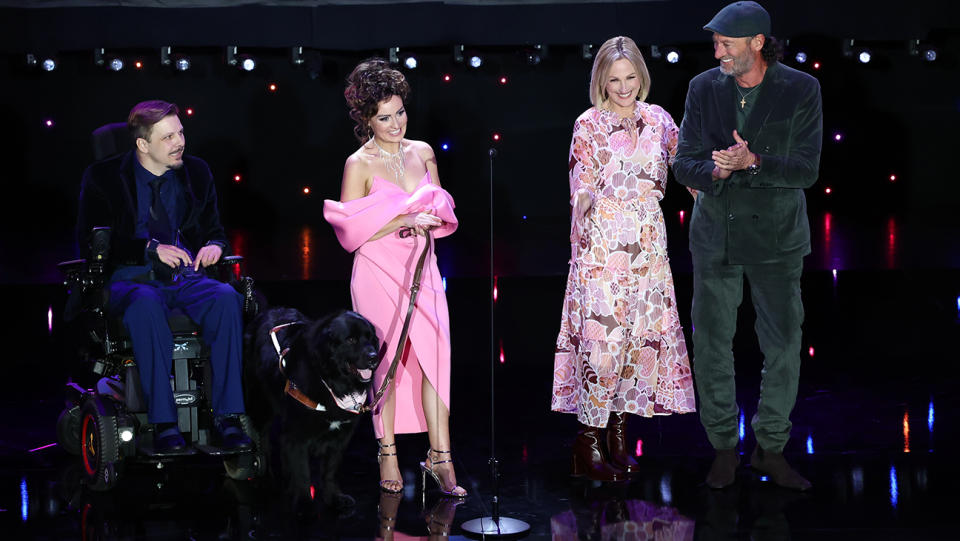
***
It’s not just the MMA space that’s accessible. As the show makes its first in-person return since the pandemic, the Media Access Awards are taking cues from its past three virtual iterations where the awards ceremony featured a track dedicated to audio description and open captions as part of its stream partnership with Extra TV.
Calla shares that for 2022, the show used open captions for the film and TV clips in-person “as the quick edits [of the montages] make it very difficult for the ASL interpreters,” but for the Dec. 3 and Dec. 15 broadcasts, closed captions are available. Audio description devices were also back in-person at the ceremony, but in a first for PBS SoCal/KCET, AD is available during the broadcast. That makes the 2023 Media Access Awards the networks’ first all-inclusive show, with plans to have the 2024 awards air on PBS National.
“I think that a show that is fully accessible, that you can see that there is a lift, there is a ramp, that you can see interpreters, you can hear audio description — all of that enriches the experience of the audience,” Calla says.
It’s a tech-heavy assistive event that Kotsur says has to be vigilantly monitored when being produced to ensure that accessibility is achieved. “It’s really important for us to check on that technology and make sure that there are batteries in the microphones, make sure that the camera frame isn’t too tight, and that you’re not missing sign language,” he says of the recorded show. “It’s new for a lot of these crews, as far as shooting sign language and how they should frame it.”
Kotsur acknowledges that a pre-recorded event, where you “can stop and fix it or shoot another take” if something goes wrong, is less of a challenge than a live telecast — the method that many of the industry’s biggest shows use. But he tells THR that what the Media Access Awards is doing “is a great first step” in imagining something more inclusive.
“It’s a different way of educating the general public and exposing them to American Sign Language and Deaf culture. So I’m very proud that PBS will be showing this on national television,” Kotsur added.
***
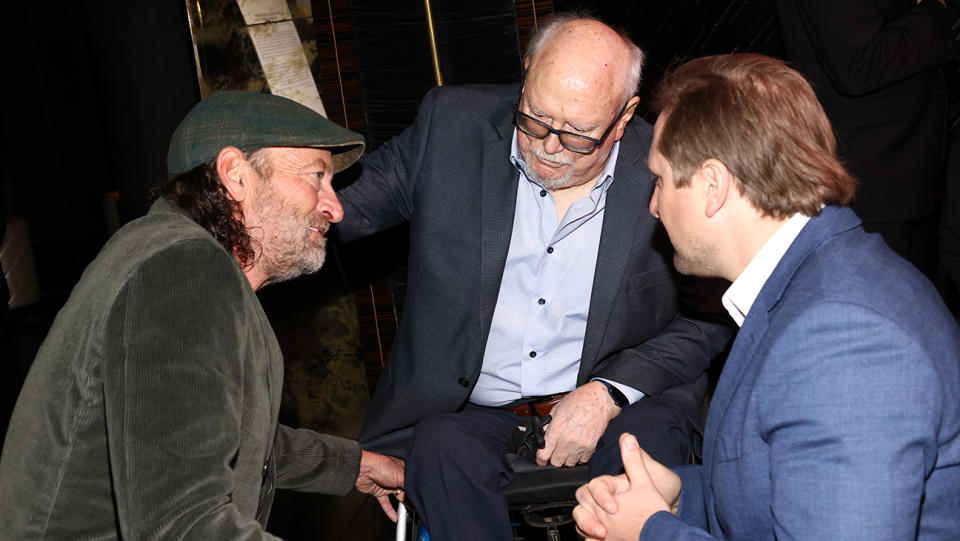
While the MMAs often go above and beyond their award-season counterparts, it’s not just the physical measures that set them apart. The show regularly hires people with disabilities as everything from production coordinators to show package editors to hosts. “Everyone has weaknesses and strengths,” says Calla. “What makes a team is organizing and coordinating around everyone’s strengths.”
It’s one area — particularly in terms of presenters and hosts — that most of Hollywood’s awards shows have yet to account for as they move to become more inclusive and accessible. While Kotsur presented the best supporting actor award at the 2023 Oscars following his 2022 win, Matlin notes that she nor Kostur were invited back to present at several other notable ceremonies following CODA winning major honors in ensemble and individual categories.
The Oscars have a standard for who presents key categories like best actor or actress each year (the previous year’s winners, if available). But more often, producers are simply tapping a spectrum of established and up-and-coming names and those topping the current box office.
“Like all award shows, there is a pecking order and the pecking order often doesn’t include representation of people with disabilities and who are Deaf,” Matlin says. “The film industry and the TV industry are just by nature, sort of strange, in that they’re more concerned about numbers of viewers and ratings, their fan base, the financials of who they love and who’s the most popular. They worry about their ratings or how they perceive what their ratings will be if you include people.”
Matlin tells THR that while she understands it as the nature of the industry, she does not believe it can’t change with the times and “reflect the diversity that’s there.”
“You don’t want to keep going over the same list, the same people year after year after year — who has a movie coming up; who has an Oscar in the past; who used to be nominated; who will be nominated; who they perceive as hot; who they think people will watch,” she says. “There are some things that happen during award shows where they’re not giving out awards. They have skits or musical numbers, they talk about an organization and it’s where we can fit in.
“Put us on stage,” she says. “Present us to the world.”
***
What Matlin is calling for is part of why she and Kotsur co-hosting the Media Access Awards this year feels so significant. “This time the show is televised with two Deaf people hosting — never having been done on television before like this. So when I was asked to do this, I said absolutely. I didn’t even have to think about it,” Matlin says. “When would this ever happen again to have two Deaf hosts for a TV show?”
Matlin adds that it’s also a key opportunity for “our peers, for people in the mainstream, to be able to see us and say look, you can pull off a show with Deaf hosts or Deaf presenters. Yes, they do it a little differently, but we made it as accessible as possible for everyone.”
Making it possible involved building — or expanding — infrastructure from previous years with a single deaf host. “We put a camera locked on the live floor interpreter, so that backstage, Marlee and Troy could continue to participate in the show and hear what everybody else was were saying,” Calla explains. “We also put an interpreter next to them backstage. The whole time anyone who was deaf or hard of hearing was able to understand, and participate in the show.”
Backstage, an interpreter would give them their cues “to let us know what was going on and when they were ready for us,” Kotsur added. Once onstage, proper lighting supported their ability to see what their respective interpreters were signing. A teleprompter also featured Marlee’s dialogue in white and his in yellow.
“That really helped me — just something that simple, of using different colors. I can see Marlee signing and I know when she’s finished. It’s similar to hearing someone finish their line, and then you know it’s your turn. For me, I have to see the line actually be completed,” Kotsur explains. “I think a lot of folks never think about that, a more visual approach.”
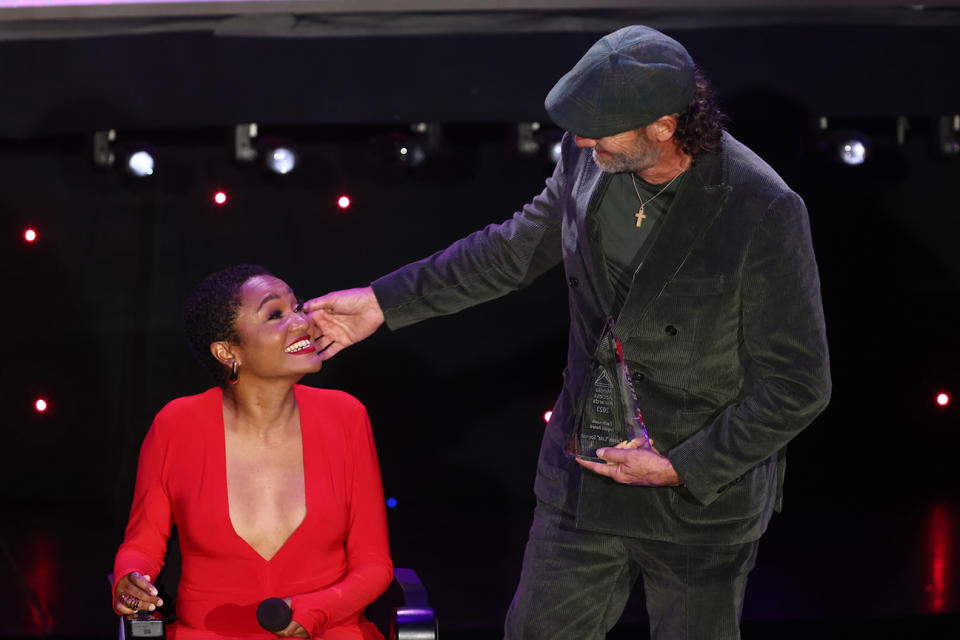
***
While Calla says no major award shows have contacted her in the past about how to expand accessibility as part of their in-person and televised shows, she’s hoping that this historic moment can help encourage them. “To me, this is not a burden. It’s actually exciting,” she tells THR. “This show is about how can I include as many people as possible in what I’m creating?”
For Matlin, the affair was “a blast” because “Troy and I had the floor for a change.” Kotsur adds that the MMAs are “ahead of the curve” and he was personally elated “that we were able to work everything out with the voice interpreters, the lighting and the sign language, and the framing of the sign language.”
“I think there’s a lot of fear,” he tells THR about why this historic moment was yet to happen before. “Folks are even afraid to ask questions or ask consultants for advice.”
“The hesitation of a lot of other programming or awards is that people tend to shy away from that which they don’t understand. If you see someone in a wheelchair, do I look at them? Do I touch them?” Calla says. “The Media Access Awards normalizes that disability experience.”
Calla also notes that the show’s own historic moment arrives as people with disabilities are starting to claim more agency within the industry. The disability community has such self-respect and is really embracing what this community is about. It’s an amazing thing to see. No longer do people feel like they’re waiting for people to give them a chance. They are taking the chance,” she says.
All of that is partly why the trio sees this moment as a possible turning point, with Hollywood now treating disability as part of the diversity narrative — something Matlin says it has not always done.
“It took this show to help people realize that things can work for anyone,” Matlin says. “It’s been a long time coming, and it was about time.”
The Media Access Awards air Sunday, Dec. 3 at 9 p.m. PT on KCET, and again on Friday, Dec. 15 at 8 p.m. PT on PBS SoCal.
This interview was conducted with the assistance of ASL interpreters Justin Maurer and Jack Jason.
Best of The Hollywood Reporter

